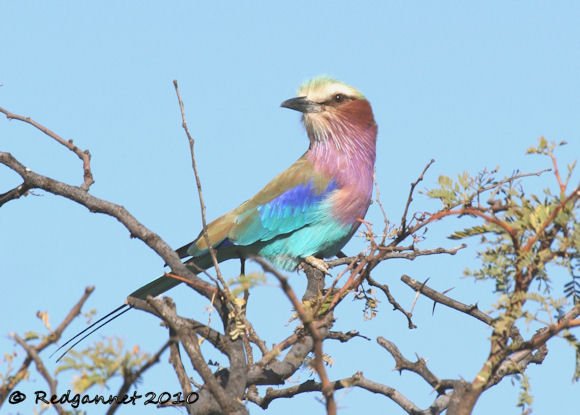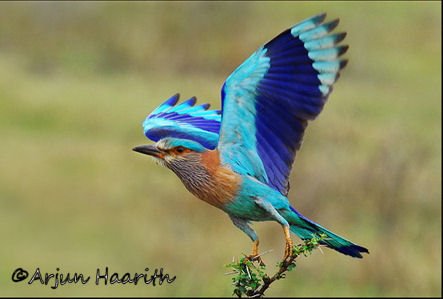If ever a family were designed to catch the eye, it is the rollers. They perch conspicuously, perform dramatic display flights and boast the most stunning plumage. They are a photographer’s dream and nightmare in one bird. The fantasy would be to catch the colours and the light to show a roller in its true majesty. The nightmare is the dawning of reality, when it becomes clear that the incredible colours cannot be reproduced my mere mortals.
At rest, they are fantastic looking birds with turquoise, lilac and cinnamon colours and in some species, trailing tail feathers and pennants.
Lilac-breasted Roller
But when they fly…..
Having tried many times, I have never attained the level of photograph that would satisfactorily describe a roller in flight. Patches of electric blue in the primaries, prime coverts and tail are set against a swathe of indigo.
The breath-taking shock of the colours when the bird takes flight or flares as it comes into land, is enough to make the toughest birder gasp. Even if I am watching a perched roller and am prepared for the flash of colour when it flies, the vivid brightness still catches me by surprise.
If the incredible colours of the plumage were not enough, rollers also have a superb display flight that I was lucky enough to witness last week in Dubai.
Am I right in thinking that Dec 31st or New Year’s Eve is the seventh day of Christmas and traditionally celebrated by the gift of “seven swans a-swimming” from my true love? During a visit to Safa Park, I was treated to the spectacle of seven rollers rolling. These were Indian Rollers.
Indian Roller Photo by Arjun Haarith
The anticipation of midnight fireworks from Burj Khalifa and Burj el Arab to welcome 2011, was trumped in the afternoon at a city park by a flock of birds. They would climb to about 30 meters and use their momentum to carry them over into a dive with marked similarity to a rollercoaster cresting the top of the first drop. Two male birds were displaying for a female adjudicator, perched in a nearby palm tree for the first show, while five more were showing off in a reprise outside the park.
Multi-million pound fireworks displays were as nothing to the show put on by the rollers.
Despite being so obvious, the rollers can be timid and will not always consent to close approach. Using a car as a hide, it is sometimes possible to get reasonably near, but the bird is often perched high which makes for a bad angle and poor lighting.
I wish that I could lay claim to the photograph above, but it was taken by Arjun Haarith who very kindly consented to allow me to use it here.
The Coraciidae is an old world family of birds, commonly and collectively known as the Rollers. From Europe, through the Middle East into Asia and south into Africa, rollers are conspicuous and easily seen. One species, the Dollarbird, even makes it as far as Australasia.
They are split into 2 genera.
Birds from the genus Eurystomas (which includes Broad-billed Roller and Dollarbird ) feed mainly on insects caught on the wing and do not participate in the dramatic courtship displays of the Coracias rollers.
The Coracias species (which include Lilac-breasted Roller, European Roller and Indian Roller) swoop down to the ground from a prominent perch to catch their prey.















Awesome photos! they are beautiful birds. I would love to see them in person some day.
What an absolutely beautiful bird, thanks for sharing..
Okay. I just fell in love.
I grew up in Sharjah in the 1970’s and wish my parents had shown me these! Dubai was a little town on the edge of a creek in those days! Al Ain had a zoo, if you could survive the road to get there!
Spectacular photos of some really great birds. Birding in Dubai sounds so exotic and intriguing it is making me very curious about the birding scene in the middle east. Anyone care to comment on what the birding situation is like in Dubai or anywhere in the region for that matter?
Thank you for the very kind comments. I hope you have taken the oportunity to visit Arjen’s site too.
For further commentary on the visit go to http://redgannet.blogspot.com/2011/01/safa-park-dubai.html
and you will find further links, including the very informative UAE birding site
Thank you Redgannet, I will check out these links, especially the UAE birding site…cheers!
Very nice blog sir !!
Nice information provided.
Thanks for sharing